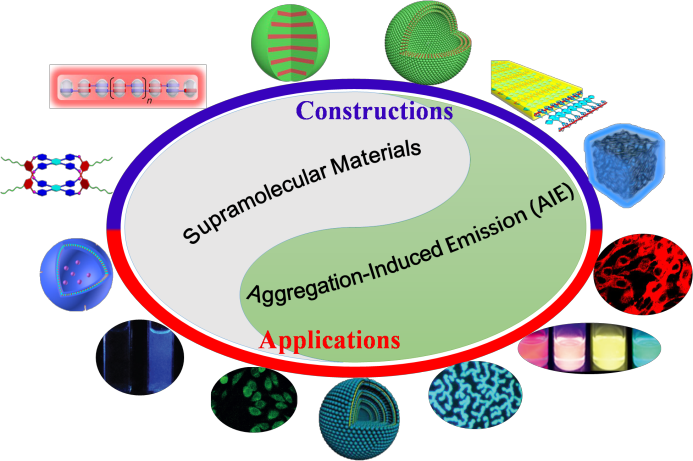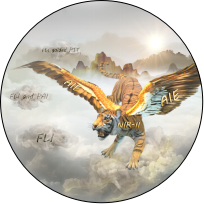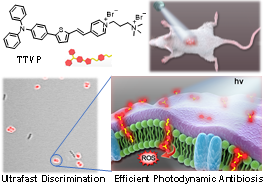Since 2020, Associate Professor Wang Dong from the AIE Research Center of College of Materials Science and Engineering has been continuously published 7 papers with impact factor greater than 10 in the journal as the corresponding author in Chem. Soc. Rev. (impact factor: 40.443), Angew. Chem. (3 articles, impact factor: 12.257), and Adv. Mater. : 25.809), Biomaterials (2 papers, impact factor: 10.27)
1. Supramolecular materials based on AIE luminogens (AIEgens): construction and applications
,Chem. Soc. Rev., 2020. DOI: 10.1039/c9cs00495e.

The emergence of aggregation-induced emission luminogens (AIEgens) has significantly stimulated the development of luminescent supramolecular materials because their strong emissions in the aggregated state have resolved the notorious obstacle of the aggregation-caused quenching (ACQ) effect, thereby enabling AIEgen-based supramolecular materials to have a promising prospect in the fields of luminescent materials, sensors, bioimaging, drug delivery, and theranostics. Moreover, in contrast to conventional fluorescent molecules, the configuration of AIEgens is highly twisted in space. Investigating AIEgens and the corresponding supramolecular materials provides fundamental insights into the self-assembly of nonplanar molecules, drastically expands the building blocks of supramolecular materials, and pushes forward the frontiers of supramolecular chemistry. In this review, we will summarize the basic concepts, seminal studies, recent trends, and perspectives in the construction and applications of AIEgen-based supramolecular materials with the hope to inspire more interest and additional ideas from researchers and further advance the development of supramolecular chemistry.
Paper link: https://pubs.rsc.org/en/content/articlelanding/2020/CS/C9CS00495E#!divAbstract
2. Angew. Chem. Int. Ed. 2020, 59, 9610-9616.DOI: 10.1002/anie.202000740

Photodynamic therapy (PDT) has long been shown to be a powerful therapeutic modality for cancer. However, PDT is undiversified and has become stereotyped in recent years. Exploration of distinctive PDT methods is thus highly in demand but remains a severe challenge. Herein, an unprecedented 1+1+1>3 synergistic strategy is proposed and validated for the first time. Three homologous luminogens with aggregation‐induced emission (AIE) characteristics were rationally designed based on a simple backbone. Through slight structural tuning, these far‐red/near‐infrared AIE luminogens are capable of specifically anchoring to mitochondria, cell membrane, and lysosome, and effectively generating reactive oxygen species (ROS). Notably, biological studies demonstrated combined usage of three AIE photosensitizers gives multiple ROS sources simultaneously derived from several organelles, which gives superior therapeutic effect than that from a single organelle at the same photosensitizers concentration. This strategy is conceptually and operationally simple, providing an innovative approach and renewed awareness of improving therapeutic effect through three‐pronged PDT.
Link to the paper: https://onlinelibrary.wiley.com/doi/full/10.1002/anie.202000740
3. Angew Chem. Int. Ed. 2020, DOI: 10.1002/anie.202005899.

Fluorescence imaging in the second near‐infrared (NIR‐II) window facilitated by aggregation‐induced emission luminogens (AIEgens) is an emerging research field. NIR‐II AIEgens overcome the bottlenecks of penetration depth and fluorescence efficiency, offering high‐performance imaging with enhanced precision. Some reported NIR‐II AIEgens demonstrate capabilities of fluorescence and photoacoustic bimodal imaging, and fluorescence imaging guided photothermal therapy, which not only improves diagnosis accuracy but provides an efficient theranostic platform to accelerate preclinical translation as well. This Minireview summarizes recent efforts on exploiting NIR‐II AIEgens with regard to molecular design strategy and bioapplications, and puts forward current challenges and promising prospects. The presented timely sketch should benefit the further exploitation of diverse and multifunctional NIR‐II AIEgens for a wide array of applications.
Link to the paper: https://onlinelibrary.wiley.com/doi/abs/10.1002/anie.202005899
4. Angew Chem. Int. Ed. 2020, DOI: 10.1002/anie.202006191.

Thanks to their intrinsic advantages, aggregation‐induced emission luminogens (AIEgens) have captivated the increasing global interest in an array of application fields. Whereas general synthetic methods towards AIEgens largely rely on tedious procedures and limited reaction types, in the related context, various innovative synthetic methodologies have emerged as complementary even alternative strategies. In this review, we systematically highlight the recent advancements on metal‐catalyzed functionalization and metal‐free promoted pathways for the construction of AIEgens over the past five years, and briefly illustrate new perspectives in this area. The timely interpretation of innovative synthetic protocols for AIEgens is promising for the future design of AIEgens allowing facile synthesis, great structural diversity and multi‐functional applications.
Link to the paper: https://onlinelibrary.wiley.com/doi/abs/10.1002/anie.202006191
5. An All-Round Athlete on the Track of Phototheranostics: Subtly Regulate the Balance between Radiative and Non-Radiative Decays for Multimodal Imaging-Guided Synergistic Therapy, Adv. Mater. 2020, DOI: 10.1002/adma.202003210

The first example of a photodynamic-photothermal combined anti-tumor AIE material that can be applied to near-infrared two-zone fluorescence imaging-photoacoustic imaging-thermal imaging three-modal optical imaging guidance was successfully prepared. Under illumination, the excited state energy of this material is fully utilized, and the radiative decay and non-radiative decay reach a perfect balance. The development of such materials not only expands the application of AIE, but also provides a good template and design ideas for the development of new and efficient optical diagnosis and treatment materials.
Link to the paper:https://onlinelibrary.wiley.com/doi/full/10.1002/adma.202003210
6. Biomaterials, 2020, 232, 119749.DOI: 10.1016/j.biomaterials.2019.119749

This paper proposes a new strategy based on stimulus response nanomicelles as the carrier of AIE photosensitizer to enhance the PDT effect, which overcomes the tight packing of AIEgens in the nanoparticle core and limited oxygen exposure. Based on the tumor microenvironment, pH-responsive and reduction-responsive nanomicelles were designed to efficiently load MeTTMN (AIE PS), and nanoparticles with stimulus-responsive AIE characteristics were prepared. The nanoparticle has good biocompatibility, high loading efficiency (DLC: 31.2%), excellent imaging function, and tumor microenvironment responsiveness, realizing efficient delivery of AIE photosensitizer and controlled release in tumor cells . Experimental results show that the stimulus-responsive AIE nanoparticles can significantly improve the ROS generation efficiency and PDT effect of the AIE photosensitizer, making it better than the commercial nanomicelles of MeTTMN. Therefore, this study provides an ideal template for the integration of fluorescence imaging and photodynamic therapy in cancer diagnosis and treatment, and also provides a promising candidate for clinical trials.
Link to the paper: https://www.sciencedirect.com/science/article/pii/S0142961219308671
7. Biomaterials, 2020, 230, 119582,DOI: 10.1016/j.biomaterials.2019.119582

Photodynamic sterilization guided by fluorescence imaging is an effective way to solve bacterial infections. However, it is a big challenge to develop a photosensitive material with simple preparation, high fluorescence brightness, long absorption and emission, quick detection and rapid differentiation of bacteria, no washing, and high sterilization efficiency. In this work, an AIE material that perfectly integrates the above properties was developed. This material can selectively target Gram-positive bacteria, and the staining can be completed in just a few seconds. Compared with the reported materials, The dyeing time has been shortened by more than 100 times. In addition, this material has excellent ability to produce reactive oxygen species, can selectively and efficiently extinguish Gram-positive bacteria, and can effectively inhibit Gram-positive bacteria infection in mouse wounds.
Link to the paper: https://www.sciencedirect.com/science/article/pii/S0142961219306817
